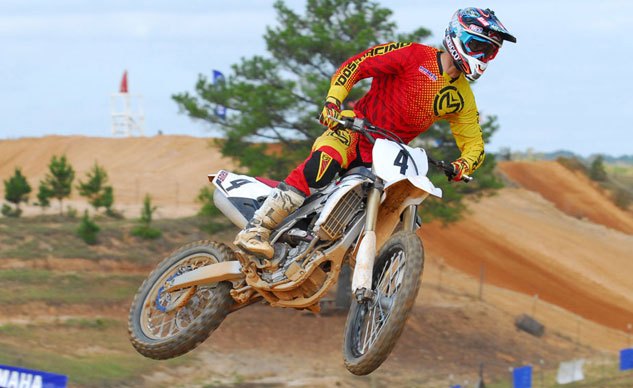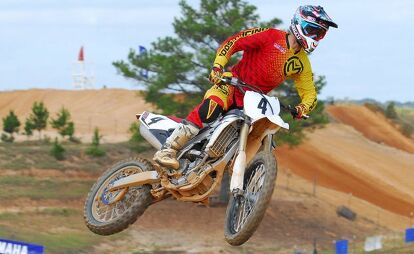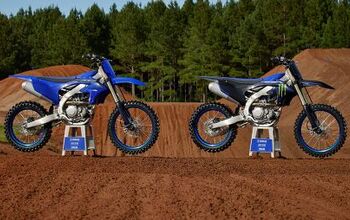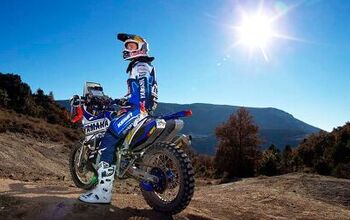2014 Yamaha YZ250F Review
Big Power, Small Package
While 16th century Italian philosopher Niccolo Machiavelli never knew the fascination that we dirtbike riders feel for modern motocross machines, his two most famous quotations sum up the 2014 Yamaha YZ250F so succinctly it’s as if he had strapped on some gear and pointed Yamaha’s practically all-new quarter-liter berm basher toward the nearest triple jump.
2014 Yamaha YZ250F
| Engine | 19/20 |
| Suspension/Handling | 15/15 |
| Transmission/Clutch | 9/10 |
| Brakes | 8/10 |
| Instruments/Controls | 5/5 |
| Ergonomics/Comfort | 10/10 |
| Appearance/Quality | 10/10 |
| Desirability | 9/10 |
| Value | 9/10 |
| Overall Score | 94/100 |
“History is written by the victors,” he once said. And also, “The end justifies the means.”
Just a few hours aboard a pre-production unit earlier this summer convinced us that the 2014 Yamaha YZ250F might be something special. Now, with two more full days of testing under our belt at the picturesque Monster Mountain MX Park near Montgomery, Alabama, we know it is.
As prologue, here’s a little history: Yamaha was the first Japanese manufacturer to produce a production-built four-stroke motocross bike that could compete head to head two-strokes when it unleashed the YZ400F in 1998. The 400F altered the technological course of motocross and off-road bikes, and it was only a matter of time before the lessons learned in its development trickled to other models.
Now here comes the part written by the victors: Yamaha claims that it reinvented the small-bore motocross class when it debuted the YZ250F in 2001. However, it could be argued by some that the company ruined it by obsoleting the much less state-of-the-art 125cc two-stroke competition in one fell swoop. All those extra moving parts, such as valves, valve springs and cams added complexity, and worse, cost, when it came time to rebuild one, and that’s something that tiddler riders have had to live with ever since. But it’s hard to stand in the way of progress, and the new YZ250F perhaps represents the most progress since the YZ400F’s debut. Not only will it add to Yamaha’s four-stroke legacy, it may write a few chapters of its own.
Engine
When we tested the pre-production YZ250F at Glen Helen Raceway, we marveled at the robust power output of its new fuel-injected motor. Strong mid-range performance and screaming top-end performance made instant fans out of us. Yamaha promised us more time aboard a bona fide production bike at Monster Mountain later in the year, and we were excited when the invitation came through. Our two days at Monster Mountain only increased our enthusiasm, as it’s our opinion that Yamaha’s re-engineering efforts more than delivered their intended performance goals.
The Monster Mountain facility features a main track that features a lot of step-up style double and triple jumps. These obstacles placed a premium on mid-range oomph since many of them required third or fourth gear in order to clear them but did not mandate strangling every last rev out of the motor. Thus, throttle response and mid-range performance were a key to fast lap times, and the YZ250F’s new reverse-incline engine possessed both the lightning-quick throttle response and abundant mid-range punch for Expert test rider Ryan Abbatoye to pop over any jump on the track with total confidence.
But there’s more going on with the new YZ250F motor than just a mere alteration of the powerband. The engine feels stronger than any stock 250cc four-stroke we’ve encountered that it was almost hard to believe that it only displaces 249cc. In fact, Yamaha officials claim that the new engine makes 40 horsepower at the rear wheel. By way of comparison, that game-changing YZ400F of 15 years ago made about 45!
The 2014 YZ250F’s 77.0 x 53.6mm bore and stroke and 13.5:1 compression ratio are the same as the 2013’s, but the greater power production comes primarily from three key areas. The first is the new Keihin 44mm throttle body, which utilizes a 10-hole injector fed by a battery-less electric fuel pump. Yamaha experimented with both 4-hole and a 12-hole injectors early in the 250F’s development before settling on the 10-holer because it delivered the overall power character its engineers were after. The 3D-mapped system collects its data from multiple sensors, reading throttle position, intake pressure, intake air temperature, crankshaft rpm and even the coolant temperature to signal the ECU to adjust the fuel mixture.
The net result is tremendous throttle response at any rpm and under any engine load. Still, as good as the new EFI is, we were slightly miffed that the YZ often failed to start on the first kick and sometimes required three or four healthy boots to fire it up when the engine was warm.
The second major improvement lies in the general architecture of the reverse-inclined engine itself. In addition to centralizing mass in the chassis, the engine’s design, which moves the cylinder from a 10.5-degree forward cant to 6.2 degrees rearward. This 16.7-degree change may not sound like much, but it effectively places the cylinder in a more vertical position while moving it 2 inches toward the center of the motorcycle. And, combined with a 3.5mm cylinder offset toward the crankshaft, it greatly reduces internal friction by placing the connecting rod in a more vertical position at the moment of greatest combustion force. This reduces sidewall friction, which in turn is reduced even further via an all-new piston that is 2.2mm shorter, 13 grams lighter and also uses a single-ring design.
The third major key lies in the revamping of the YZ’s reverse-mounted DOHC cylinder head. The new downdraft design, which places the air filter right behind the steering head, allows the intake charge a 30-degree straighter shot into the combustion chamber, and its symmetrical ports increase velocity while reducing turbulence for better cylinder filling. The new four-valve head also carries one less intake valve, utilizing titanium valves that measure 31mm on the intake side and 25mm on the exhaust. The valve angle is also a much narrower 23.7 degrees compared to 30.5 degrees on the old motor.
The reward for all of Yamaha’s hard work is an engine that produces mind-boggling power for its displacement size. It’s an overachiever in the mid-range and a strong contender up top, but what really surprised us at Monster Mountain was just how much low-end torque is available as well. During day two of our test, rain forced a delay in riding the main track, so we spent much our time riding the shorter “vintage track,” which is composed of European-style deep sand. The YZ250F’s ability to churn out of low-speed corners in third gear without major clutch abuse was impressive indeed.
The 250F’s broad torque doesn’t require nearly as many shifts per lap to keep the motor singing, but that extra oomph did require stronger third and fourth gearsets as well as fitting the clutch with a stouter pressure plate to handle the extra load placed on its five-speed transmission. Additionally, Yamaha engineers focused on improving the 250F’s shifting by installing new shift forks, redesigning the shift bars by making them float on springs to reduce binding and fitting the shifting mechanism with a bearing to reduce friction. The shift lever and shift shaft are also new. With more time aboard the bike, our take is that the clutch action is excellent and the overall shift quality very good, although some of our less experienced testers still complained of an occasional missed shift.
Chassis
No one ever complained about the handling character of the 2013 YZ250F, but since there was no way to fit the new engine in the old chassis, Yamaha engineers swapped it out for an all-new aluminum bilateral beam design that features the exact same rake and trail figures as the 2013 but is 14mm narrower at its widest point to give the 2014 model a slimmer and more compact feel. In fact, this same chassis is also used on the 2014 YZ450F—only the motor mounts distinguish the two.
Since the 250F now uses the same engine configuration as its big sister, it follows that its mass-centralizing theme also includes a wraparound head pipe and a more compact muffler that’s repositioned 186mm further forward behind the side panel and lower and closer to the middle of the chassis. The 2014 250F’s half-gallon-larger 2.1-gallon fuel tank is also rearward and lower in the chassis., and the fuel filler is now located below the frame spars. Refueling is accomplished by removing the forward section of the seat to access the recessed fuel cap.
We were fans of the YZ250F’s cornering prowess when we rode it at Glen Helen, and nothing at Monster Mountain has changed our minds. The 2014 model turns in with precision and holds its line through corners with authority. Monster Mountain’s red clay tended to form long, deep ruts in the corners, but the 250F hunkered down and handled them with ease. At the same time, we never experienced a hint of headshake on the YZ250F, and can’t say that about the 2014 YZ450F. The YZ250F delivers intuitive cornering and rock-solid stability in wet or dry conditions, on loose or tight racetracks, in any corner or over any jump. Can it even be more awesome?
Suspension
During the YZ250F technical presentation on the first night, Yamaha’s crew received a round of applause when it reconfirmed that the YZ250F’s fork still incorporates one coil spring and one cartridge per fork leg rather than using one spring for both legs, or even compressed air in lieu of coil springs. That’s because the word has already begun to circulate that the air forks in particular require more maintenance and don’t deliver the consistent damping over long motos like their designers had intended. By sticking with a tried-and-true fork design, Yamaha sidesteps any controversy.
Not that the KYB fork doesn’t feature impressive technology. Just proven technology. Its Speed Sensitive valving system, which uses piston speed to control the damping, delivers very good performance over a wide range of conditions. We noticed a slight harshness initially, but the more we rode the bike the less of an issue it became. The fork worked in perfect harmony with the fully adjustable KYB shock mated to the YZ’s aluminum swingarm and rising-rate shock linkage. The rear end tracked straight and true through all of the bumps at Monster Mountain, same as it had at Glen Helen, again without requiring us to do any more than set the rear suspension sag to find happiness.
Brakes/Tires
The YZ250F’s wave rotor disc brakes are about the only thing that isn’t new on the 2014 model, and that’s just fine, as the two-piston-clamped the 250mm front disc and single-piston 245mm rear are more than capable of slowing the 250’s claimed 231-lbs. with authority. Both the front and the rear serve up strong stopping power without feeling overly sensitive regardless of terrain. Of course, we also have to give some credit to the stock Bridgestone M404-A front and M403 rear tires, which exhibit a consistent feel on hard or soft riding conditions.
Ergonomics/Styling
The absence of a gas cap on top the YZ250F’s tank allows the rider to move forward on its slim seat without fear of catching one’s “self,” thus adding to its cornering confidence, and although the 2014 model features larger capacity radiators to increase cooling, they are tucked in nicely to eliminate the chance of catching a boot on the radiator shrouds during hard cornering. We liked the handlebar just as it was set in its stock position, but the bar can be adjusted to any of four positions to facilitate rider size and/or comfort. The bars are also rubber-mounted atop the YZ’s new, more rigid triple clamp to minimize vibration through the rider’s hands. Overall, we are very pleased with the ergonomics.
Our Monster Mountain test unit also featured Yamaha’s optional white/red/black graphics scheme with black rims for added sex appeal. And the graphics should stay good-looking for a long time, thanks to a new process by which they are embedded into the plastic, making them impossible to peel off and more resistant to scratches.
With all of the work that went into making the 2014 Yamaha YZ250F a more capable motocrosser, we find it hard to believe that the new model commands only $200 more than the old one. For $7490, you’ll have to go a long way to find a 250cc four-stroke that packs more power and better handling than the YZ does, but that’s what shootouts are for. Based on its engine performance alone, we’re confident that the YZ will be a tough contender, and we won’t be surprised if it regains the top spot in the class. This is one badass 250.
2014 Yamaha YZ250F Specs
| MSRP | $7,490 |
| Engine Type | Liquid-cooled four-stroke single, DOHC four-valve head |
| Engine Capacity | 249cc |
| Bore x Stroke | 77.0 x 53.6mm |
| Compression | 13.5:1 |
| Fuel System | Keihin EFI, 44m throttle body |
| Ignition | TCI |
| Horsepower | 40 (claimed) |
| Transmission | 5-speed |
| Final Drive | Chain |
| Frame | Bilateral beam aluminum |
| Front Suspension | Inverted KYB fully adj. fork w/Speed Sensitive System; 12.2 in. of travel |
| Rear Suspension | KYB fully adjustable monoshock w/piggyback reservoir, 50mm piston; 12.4 in. of travel |
| Front Brakes | Nissin two-piston caliper 250mm wave-style disc |
| Rear Brakes | Nissin single-piston caliper 245mm wave-style disc |
| Front Tire | Bridgestone M404-A 80/100-21 |
| Rear Tire | Bridgestone M403 100/90-19 |
| Seat Height | 38.0 inches |
| Curb Weight | 231 lbs |
| Wheelbase | 58.1 inches |
| Ground Clearance | 12.8 inches |
| Fuel Capacity | 2.1 gal |
| Colors | Blue/White and White/Red/Black |
More by Scott Rousseau



















































![2010 Yamaha YZ250F Preview [video]](https://cdn-fastly.motorcycle.com/media/2023/05/31/11737126/2010-yamaha-yz250f-preview-video.jpg?size=350x220)
















Comments
Join the conversation
WR version please. That motor sounds perfect for off road.
Totally agree, picked up a used, modded WR250R and couldn't be happier.